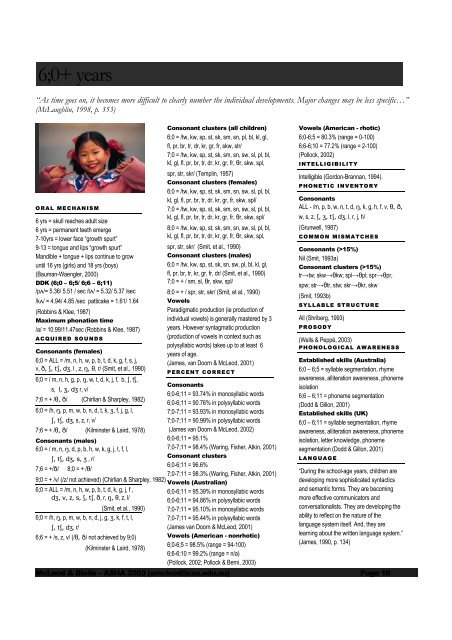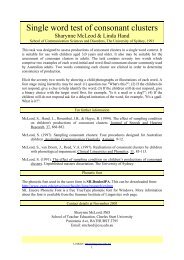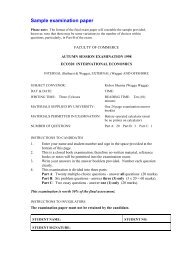6;0+ years“As time goes on, it becomes more difficult to clearly number the individual developments. Major changes may be less specific…”(McLaughlin, 1998, p. 353)ORAL MECHANISM6 yrs = skull reaches adult size6 yrs = permanent teeth emerge7-10yrs = lower face “growth spurt”9-13 = tongue <strong>and</strong> lips “growth spurt”M<strong>and</strong>ible + tongue + lips continue to growuntil 16 yrs (girls) <strong>and</strong> 18 yrs (boys)(Bauman-Waengler, 2000)DDK (6;0 – 6;5/ 6;6 – 6;11)/p√/= 5.36/ 5.51 / sec /t√/ = 5.32/ 5.37 /sec/k√/ = 4.94/ 4.85 /sec patticake = 1.61/ 1.64(Robbins & Klee, 1987)Maximum phonation time/a/ = 10.99/11.47sec (Robbins & Klee, 1987)ACQUIRED SOUNDSConsonants (females)6;0 = ALL = /m, n, h, w, p, b, t, d, k, g, f, s, j,v, D, S, tS, dZ, l , z, N, T, r/ (Smit, et al., 1990)6;0 = / m, n, h, g, p, N, w, t, d, k, j, f, b, S, tS,s, l, Z, dZ r, v/7;6 = + /T, D/ (Chirlian & Sharpley, 1982)6;0 = ALL = /m, n, h, w, p, b, t, d, k, g, j, f ,dZ, v, z, s, S, tS, D, r, N, T, z, l/(Smit, et al., 1990)6;0 = /h, N, p, m, w, b, n, d, j, g, Z, k, f, t, l,S, tS, dZ, r/6;6 = + /s, z, v/ (/T, D/ not achieved by 9;0)(Kilminster & Laird, 1978)Consonant clusters (all children)6;0 = /tw, kw, sp, st, sk, sm, sn, pl, bl, kl, gl,fl, pr, br, tr, dr, kr, gr, fr, skw, str/7;0 = /tw, kw, sp, st, sk, sm, sn, sw, sl, pl, bl,kl, gl, fl, pr, br, tr, dr, kr, gr, fr, Tr, skw, spl,spr, str, skr/ (Templin, 1957)Consonant clusters (females)6;0 = /tw, kw, sp, st, sk, sm, sn, sw, sl, pl, bl,kl, gl, fl, pr, br, tr, dr, kr, gr, fr, skw, spl/7;0 = /tw, kw, sp, st, sk, sm, sn, sw, sl, pl, bl,kl, gl, fl, pr, br, tr, dr, kr, gr, fr, Tr, skw, spl/8;0 = /tw, kw, sp, st, sk, sm, sn, sw, sl, pl, bl,kl, gl, fl, pr, br, tr, dr, kr, gr, fr, Tr, skw, spl,spr, str, skr/ (Smit, et al., 1990)Consonant clusters (males)6;0 = /tw, kw, sp, st, sk, sn, sw, pl, bl, kl, gl,fl, pr, br, tr, kr, gr, fr, dr/ (Smit, et al., 1990)7;0 = + / sm, sl, Tr, skw, spl/8;0 = + / spr, str, skr/ (Smit, et al., 1990)VowelsParadigmatic production (ie production <strong>of</strong>individual vowels) is generally mastered by 3years. However syntagmatic production(production <strong>of</strong> vowels in context such aspolysyllabic words) takes up to at least 6years <strong>of</strong> age.(James, van Doorn & McLeod, 2001)PERCENT CORRECTConsonants6;0-6;11 = 93.74% in monosyllabic words6;0-6;11 = 90.76% in polysyllabic words6;0 = /h, N, p, m, w, b, n, d, t, k, Z, f, j, g, l,S, tS, dZ, s, z, r, v/7;0-7;11 = 93.93% in monosyllabic words7;0-7;11 = 90.99% in polysyllabic words7;6 = + /T, D/ (Kilminster & Laird, 1978) (James van Doorn & McLeod, 2002)Consonants (males)6;0 = / m, n, N, d, p, b, h, w, k, g, j, t, f, l,S, tS, dZ, s, Z , r/6;0-6;11 = 95.1%7;0-7;11 = 98.4% (Waring, Fisher, Atkin, 2001)Consonant clusters6;0-6;11 = 96.6%7;6 = +/D/ 8;0 = + /T/7;0-7;11 = 98.3% (Waring, Fisher, Atkin, 2001)9;0 = + /v/ (/z/ not achieved) (Chirlian & Sharpley, 1982)Vowels (Australian)6;0-6;11 = 95.39% in monosyllabic words6;0-6;11 = 94.86% in polysyllabic words7;0-7;11 = 95.10% in monosyllabic words7;0-7;11 = 95.44% in polysyllabic words(James van Doorn & McLeod, 2001)Vowels (American - nonrhotic)6;0-6;5 = 98.5% (range = 94-100)6;6-6;10 = 99.2% (range = n/a)(Pollock, 2002; Pollock & Berni, 2003)Vowels (American - rhotic)6;0-6;5 = 80.3% (range = 0-100)6;6-6;10 = 77.2% (range = 2-100)(Pollock, 2002)INTELLIGIBILITYIntelligible (Gordon-Brannan, 1994).PHONETIC INVENTORYConsonantsALL - /m, p, b, w, n, t, d, N, k, g, h, f, v, T, D,w, s, z, S, Z, tS, dZ, l, r, j, h/(Grunwell, 1987)COMMON MISMATCHESConsonants (>15%)Nil (Smit, 1993a)Consonant clusters (>15%)tr→tw; skw→Tkw; spl→Tpl; spr→Tpr,spw; str→Ttr, stw; skr→Tkr, skw(Smit, 1993b)SYLLABLE STRUCTUREAll (Shriberg, 1993)PROSODY(Wells & Peppé, 2003)PHONOLOGICAL AWARENESSEstablished skills (Australia)6;0 – 6;5 = syllable segmentation, rhymeawareness, alliteration awareness, phonemeisolation6;6 – 6;11 = phoneme segmentation(Dodd & Gillon, 2001)Established skills (UK)6;0 – 6;11 = syllable segmentation, rhymeawareness, alliteration awareness, phonemeisolation, letter knowledge, phonemesegmentation (Dodd & Gillon, 2001)LANGUAGE“During the school-age years, children aredeveloping more sophisticated syntactics<strong>and</strong> semantic forms. They are becomingmore effective communicators <strong>and</strong>conversationalists. They are developing theability to reflect on the nature <strong>of</strong> thelanguage system itself. And, they arelearning about the written language system.”(James, 1990, p. 134)McLeod & Bleile – ASHA 2003 (smcleod@csu.edu.au) Page 10
ReferencesAguilar-Mediavilla, E. M., Sanz-Torrent, M., & Serra-Raventos, M. (2002). A comparative study <strong>of</strong> the phonology <strong>of</strong> pre-school children with specific language impairment (SLI),language delay (LD) <strong>and</strong> normal acquisition. Clinical Linguistics & Phonetics, 16(8), 573-596.Bauman-Waengler, J. (2000). Articulation <strong>and</strong> phonological impairments: A clinical focus. Needham Heights, MA: Allyn & Bacon.Bernthal, J. E., & Bankson, N. W. (1998). Articulation <strong>and</strong> phonological disorders. (4th ed.). Needham Heights, MA: Allyn & Bacon.Bleile, K. (forthcoming). Manual <strong>of</strong> articulation <strong>and</strong> phonological disorders (Second Edition). New York: Delmar.Chirlian, N. S., & Sharpley, C. F. (1982). Children's articulation development: Some regional differences. Australian Journal <strong>of</strong> Human Communication Disorders, 10, 23-30.Dodd, B. (1995). Children's acquisition <strong>of</strong> phonology. In B. Dodd (Ed.), Differential diagnosis <strong>and</strong> treatment <strong>of</strong> speech disordered children (pp. 21-48). London: Whurr.Dodd, B., & Gillon, G. (2001). Exploring the relationship between phonological awareness, speech impairment, <strong>and</strong> literacy. Advances in Speech-Language Pathology, 3, 139-147.Donegan, P. (2002). Normal vowel development. In M. J. Ball, & F. E. Gibbon (Eds). Vowel disorders (pp. 1-35). Woburn, MA: Butterworth-Heinemann.Dyson, A. T. (1988). Phonetic inventories <strong>of</strong> 2- <strong>and</strong> 3- year old children. Journal <strong>of</strong> Speech <strong>and</strong> Hearing Disorders, 53, 89-93.Gordon-Brannan, M. (1994). Assessing intelligibility: Children's expressive phonologies. Topics in Language Disorders, 14, 17-25.Grunwell, P. (1981). The development <strong>of</strong> phonology: A descriptive pr<strong>of</strong>ile. First Language, 3, 161-191.Grunwell, P. (1987). Clinical phonology. (2nd ed.). London: Croom Helm.Haelsig, P. C., & Madison, C. L. (1986). A study <strong>of</strong> phonological processes exhibited by 3-, 4-, <strong>and</strong> 5-year-old children. Language, Speech, <strong>and</strong> Hearing <strong>Services</strong> in Schools, 17, 107-114.James, D. G. H. (2001a). The use <strong>of</strong> phonological processes in Australian children aged 2 to 7:11 years. Advances in Speech-Language Pathology, 3, 109-128.James, D. G. H. (2002). Part II: On assessing normal speech development. ACQuiring Knowledge in Speech, Language <strong>and</strong> Hearing, 4, 147-150.James, D., McCormack, P., & Butcher, A. (1999). Children's use <strong>of</strong> phonological processes in the age range <strong>of</strong> five to seven years. In S. McLeod & L. McAllister (Eds.), Proceedings <strong>of</strong>the 1999 Speech Pathology Australia National Conference (pp. 48-57). Melbourne: Speech Pathology Australia.James, D., van Doorn, J. & McLeod, S. (2001). Vowel production in mono-, di-<strong>and</strong> poly-syllabic words in children 3;0 to 7;11 years. In L. Wilson & S. Hewat (Eds.). Proceedings <strong>of</strong> theSpeech Pathology Australia Conference. (pp. 127-136). Melbourne: Speech Pathology Australia.James, D., van Doorn, J., McLeod, S. (2002). Segment production in mono-, di- <strong>and</strong> polysyllabic words in children aged 3-7 years. In F. Windsor, L. Kelly & N. Hewlett (Eds.) Themes inClinical Phonetics <strong>and</strong> Linguistics (pp. 287 – 298), Hillsdale, NJ: Lawrence Erlbaum.James, S. L. (1990). Normal language acquisition. Boston, MA: Allyn & Bacon.Kehoe, M. (1997). Stress error patterns in English-speaking children's word productions. Clinical Linguistics <strong>and</strong> Phonetics, 11, 389-409.Kehoe, M. M. (2001). Prosodic patterns in children's multisyllabic word productions. Language, Speech, <strong>and</strong> Hearing <strong>Services</strong> in Schools, 32, 284-294.Kilminster, M. G. E., & Laird, E. M. (1978). Articulation development in children aged three to nine years. Australian Journal <strong>of</strong> Human Communication Disorders, 6, 23-30.Locke, J. L. (2002). Vocal development in the human infant: Functions <strong>and</strong> phonetics. In F. Windsor, M. L. Kelly, & N. Hewlett (Eds.), Investigations in clinical phonetics <strong>and</strong> linguistics(pp. 243-256). Hillsdale, NJ: Lawrence Erlbaum.Lowe, R. J., Knutson, P. J., & Monson, M. A. (1985). Incidence <strong>of</strong> fronting in preschool children. Language, Speech, <strong>and</strong> Hearing <strong>Services</strong> in Schools, 16, 119-123.McGlaughlin, A., & Grayson, A. (2003). A cross sectional <strong>and</strong> prospective study <strong>of</strong> crying in the first year <strong>of</strong> life. In S. P. Sohov (Ed.), Advances in Psychology Research (Vol. 22, pp. 37-58). New York: Nova Science.McLaughlin, S. (1998). Introduction to language development. San Diego, CA: Singular.McLeod, S. (2002). Part I: The plethora <strong>of</strong> available data on children's speech development. ACQuiring Knowledge in Speech, Language <strong>and</strong> Hearing, 4, 141-147.McLeod, S. (2003). General trends <strong>and</strong> individual differences: Perspectives on normal speech development. In S. P. Sohov (Ed.), Advances in Psychology Research (Vol. 22, pp. 189-202). New York: Nova Science.McLeod, S., van Doorn, J., & Reed, V. A. (2001a). Normal acquisition <strong>of</strong> consonant clusters. American Journal <strong>of</strong> Speech-Language Pathology, 10, 99-110.McLeod, S., van Doorn, J., & Reed, V. A. (2001b). Consonant cluster development in two-year-olds: General trends <strong>and</strong> individual difference. Journal <strong>of</strong> Speech, Language, HearingResearch, 44, 1144-1171.McLeod, S., van Doorn, J., & Reed, V. A. (2002). Typological description <strong>of</strong> the normal acquisition <strong>of</strong> consonant clusters. In F. Windsor, L. Kelly, & N. Hewlett (Eds.), Themes in ClinicalPhonetics <strong>and</strong> Linguistics (pp. 185 - 200). Hillsdale, NJ: Lawrence Erlbaum.Mitchell, P. R. (1997). Prelinguistic vocal development: A clinical primer. Contemporary Issues in Communication Science <strong>and</strong> Disorders, 24, 87-92.Oller, D. K., Eilers, R. E., Neal, A. R., & Schwartz, H. K. (1999). Precursors to speech in infancy: The prediction <strong>of</strong> speech <strong>and</strong> language disorders. Journal <strong>of</strong> CommunicationDisorders, 32, 223-245.Otomo, K., & Stoel-Gammon, C. (1992). The acquisition <strong>of</strong> unrounded vowels in English. Journal <strong>of</strong> Speech <strong>and</strong> Hearing Research, 35, 604-616.Owens, R. E. (1994). Language development: An introduction (4 th ed.). Boston, MA: Allyn & Bacon.Pollock, K. E. (2002). Identification <strong>of</strong> vowel errors: Methodological issues <strong>and</strong> preliminary data from the Memphis Vowel Project. In M. J. Ball & F. E. Gibbon (Eds.), Vowel disorders(pp. 83-113). Boston: Butterworth Heinemann.Pollock, K. E., & Berni, M. C. (2003). Incidence <strong>of</strong> non-rhotic vowel errors in children: Data from the Memphis Vowel Project. Clinical Linguistics <strong>and</strong> Phonetics, 17, 393-401.Porter, J. H., & Hodson, B. W. (2001). Collaborating to obtain phonological acquisition data for local schools. Language, Speech, <strong>and</strong> Hearing <strong>Services</strong> in Schools, 32, 165-171.Preisser, D. A., Hodson, B.W., & Paden, E.P. (1988). Developmental phonology: 18-29 months. Journal <strong>of</strong> Speech <strong>and</strong> Hearing Disorders, 53, 125-130.Robb, M. P., & Bleile, K. M. (1994). Consonant inventories <strong>of</strong> young children from 8 to 25 months. Clinical Linguistics <strong>and</strong> Phonetics, 8, 295-320.Robbins, J., & Klee, T. (1987). Clinical assessment <strong>of</strong> oropharyngeal motor development in young children. Journal <strong>of</strong> Speech <strong>and</strong> Hearing Disorders, 52, 271-277.Roberts, J. E., Burchinal, M., & Footo, M.M. (1990). Phonological process decline from 2;6 to 8 years. Journal <strong>of</strong> Communication Disorders, 23, 205-217.McLeod & Bleile – ASHA 2003 (smcleod@csu.edu.au) Page 10





